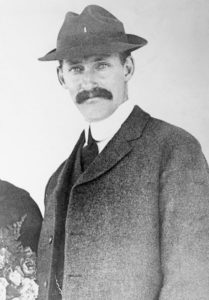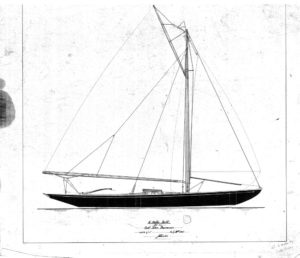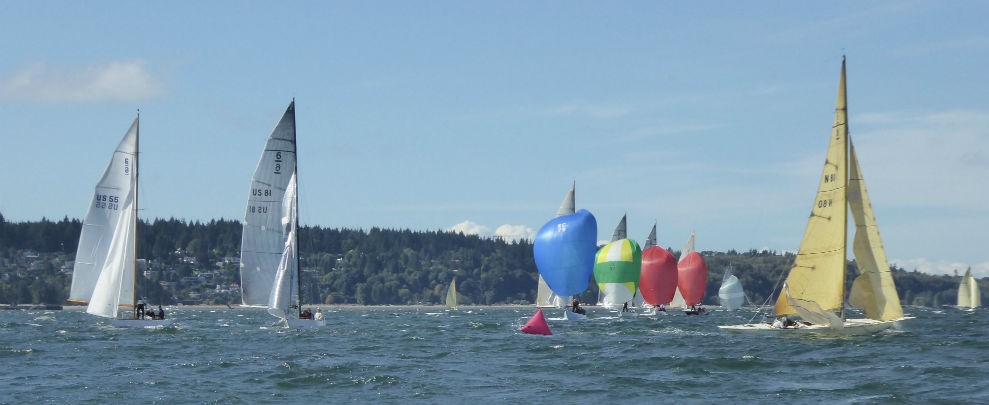The boats that sailed a century ago – part 8: Jeanie
July 26th, 2021

100 years of racing
2021 is the centenary year of the British American Cup, the first major trophy for international team racing. The competition was hugely popular and was a further boost for the increasingly successful International Six Metre Class.
The eight entrants in 1921 – four each for Britain and America – were launched in the same year. This article is the last of a series of posts to mark the centenary of the launch of the eight pioneering international team racing boats.
The American team – Jeanie
Jeanie was designed and built by William Starling Burgess and Frank C Paine. She was not the only boat on the team designed by Burgess: Sheila was also the work of the American designer.
Being the first American second rule Six Metre, Jeanie was given the sail number US1. However, there were at least two other first rule Six Metres made in America. Lady Betty, designed by the Dickie Bros. and built by Frank Stone, has been called “the real US1”. An even earlier American Six Metre appears in the ISMA Archive; the 1911 Gardner Pachita, but little is known about her. William Gardner received his education in Britain and so it may not be surprising that he was the first to experiment with the International Metre rule in America.
Norman Skene drew up the construction plans for Jeanie from Burgess and Paine’s designs. As such, she was similar in design to Sheila, built by Herreshoff Manufacturing co. She had the short ends and the bent mast of Sheila.
Skene is known for his book, Elements of Yacht Design, first published in 1904. He was multidisciplined much like Burgess — a designer, builder, engineer and mathematician.
Jeanie was owned by Frank Paine. He had worked with Burgess and L Francis Herreshoff at Herreshoff Manufacturing co, and then co-founded Burgess and Paine from 1921, which later became Burgess, Paine and Swasey.
Paine was the son of General Charles J Paine of Boston, a three times owner of the successful America’s Cup defenders for the New York Yacht Club. Some of his yachts were designed by Burgess.
Frank Paine designed at least six other Six Metre yachts. Four of these were built at George Lawley and Son of whom Paine was president for many years. Paine designed the Lawley built Undertaker and Paine’s own Sakie, both of which unsuccessfully trialled for the British American Cup of 1922.
The influence on yacht design in the early twentieth century of Burgess, Paine, Skene, Swasey, and the Herreshoffs, all of whom are regularly described as geniuses, cannot be understated.
The races

William “Starling” Burgess. Image in the public domain
Jeanie was crewed by Burgess and Paine along with L Francis Herreshoff. Like her fellow competitors Montauk and Sheila, she struggled in the races, with all three suffering damaged masts before even reaching the starting line in the first race. She followed with 5th, 6th, 8th, and 5th position finishes, and the last race, her best finish, 4th. She totalled 17 points and was saved from scoring the lowest total by Sheila, who appears to have been generally faster, but failed to finish three races.
After the British American Cup
It has already been stated in this series that America were finding their feet in 1921, being new to the International Rule. In 1922 they followed up with a 111 points to 94 points win over the British, hosted in Oyster Bay by the Seawanhaka Corinthian yacht Club, Long Island, New York.
Jeanie stayed in Britain after the cup and was owned in 1922 by C B Hill of Dorset and was registered in Poole. Hill was a land agent working for Lord Wimborne. She was converted to a cruiser and dropped out the class.
Jeanie was then renamed Genesta and registered in Liverpool by architect George Edward Marshall of G E Marshall & Co, a company known for building cinemas in the early 20th century.
Partly due to the masts being carried off during the races in 1921, the International Rule was changed to ban the bent mast design like those of Jeanie, and Sheila.
Today
Jeanie, most recently renamed Jean and not to be confused with the British Camper and Nicholson Jean, was last registered having returned to Poole, and is known to have been kept out of the water on a beach. It is not known if she was dismantled or restored.
ISMA Archive has talked to people living in America, Britain, Switzerland, Argentina, France, and Germany with fond memories of six of the eight Six Metres that raced in the British American Cup. This is unfortunately not the case with Jeanie and the British Jean, but it is clear the impact that these Six Metres have had on generations of keen sailors.
Let us know if you have any information about Jean (Ex Genesta, ex Genie, ex Jeanie).
A privilege
It has been a privilege to research the history of the eight pioneer yachts. They were built to the new International Second rule launched in 1921 to race the first British American Cup, a competition which was hugely popular — in fact, regularly front page news — and which promoted rapid development of the Six Metre Class and all International Classes.
The lives of the designers, skippers and crew crossed in many ways through war, business and politics before being brought together in competition about which commentaries often described great sportsmanship, camaraderie and even blossoming love.
The legacy of this remarkable competition lives on today, one hundred years after the first races and the fierce international competition of the Six Metres and their sailors remains.
Posted in Anniversary by James Harris on July 26th, 2021. Tags: British American Cup, Burgess, Jeanie, Paine, Sailing, Six Meter, Six Metre
Subscribe to comments | Both comments and pings are currently closed.
We need your support
Support our project and submit your records or make a donation to the International Six Metre Archive.


